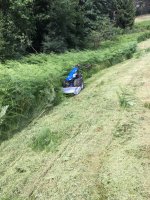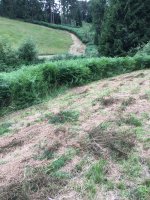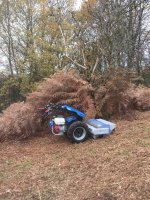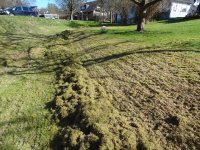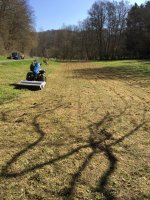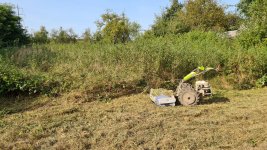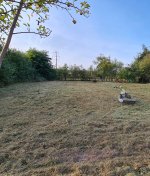Hi again travisbb

It sounds like you have found a very good pattern when you are mowing your plot, allowing you to mow in a circular manner, downhill at the steepest parts, uphill on the not so steep parts, and when mowing along the slope, hanging to the right. - Sounds perfect to me

As said, I will try to remember your hints, and also try out the steering brakes even when I use the differential lock. I am still puzzled though, but at the same time curious and eager to learn.
As you have probably seen already, steering brakes have been a frequent topic over the years in this forum. Some members use them a lot, others hardly use them at all. Personal taste differs, and perhaps they also make more sense to use with some implements, and less with others. I don’t use mine much, as I prefer to have a firm grip on both handles at all time, and steer with a light sideway pressure on the handlebars. Since I got the Berta flail mower though, I use the steering brakes a little more, as I often mow in 1st gear now, and feel more comfortable using the steering brake when driving slowly. I have often read posts praising the use of steering brakes when working across slopes, and this has always puzzled me a little. In order to prevent the tractor from turning downhill, one might brake the uphill wheel, but that is the wheel having the least traction, reducing the effect of braking accordingly. This is just one of the advantages of the 2-wheel tractor models with hydrostatic transmission, as they can run the downhill wheel slightly faster than the uphill one, thereby maintaining direction. - Perhaps I have missed something here?

Like you, I also try to turn without having to use the reverse gear, whenever possible. I have had a few scary moments where the reverse lever got stocked in neutral, either because the lever got tangled in low hanging branches or due to my own clumsiness, and on a slope, that can really get your attention! Turning like you describe is a very good alternative to reversing I have also found, especially if one makes the turns uphill.
I also only change gear when on more or less level ground, to avoid getting stuck in neutral. There might be a difference in the way the reverse mechanism on a BCS and a Grillo works, I don’t know. On my BCS, the reverse handle has to pass a detent halfway between forward and reverse. At this detent there is a neutral, preventing forward and reverse to be selected at the same time. If the change of direction is made swiftly, all is good as neutral is passed in a split second. If on the other hand the handle for some reason get stucked, the wheels are free to spin just like when neutral is selected with the gear lever. This might come as a very unpleasant and dangerous surprise!

Best regards
Jens
